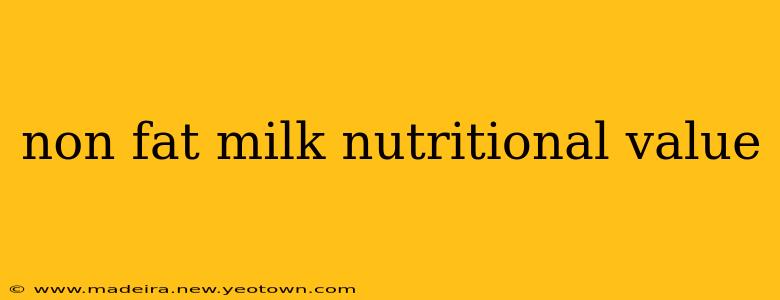For years, nonfat milk has been a staple in health-conscious households, often viewed as a lighter, healthier alternative to its whole-milk counterpart. But beyond the reduced fat content, lies a surprisingly rich nutritional profile. This isn't just about cutting calories; nonfat milk offers a valuable contribution to a balanced diet, packed with essential vitamins and minerals crucial for overall well-being. Let's delve into the world of nonfat milk and uncover its often-underestimated nutritional power.
What are the Nutritional Benefits of Nonfat Milk?
Nonfat milk, also known as skim milk, boasts a significantly lower fat content than whole milk, while retaining many of the essential nutrients. This makes it a versatile choice for individuals looking to manage their calorie intake without sacrificing essential vitamins and minerals. It's a fantastic source of calcium, crucial for strong bones and teeth, and protein, vital for muscle building and repair. Moreover, it's fortified with vitamins like Vitamin D and Vitamin A, contributing to immune function and overall health.
Is Nonfat Milk Good for Weight Loss?
This is a question frequently asked, and the answer is largely yes. Because of its lower fat content compared to whole milk, nonfat milk significantly reduces the calorie count per serving. This can be a beneficial component of a weight-loss plan, contributing to a calorie deficit without compromising on nutritional intake. However, it's important to remember that weight loss is a holistic process involving diet and exercise. Simply switching to nonfat milk won't magically melt away pounds; it's part of a larger, balanced approach.
Does Nonfat Milk Have Any Downsides?
While nonfat milk offers numerous advantages, it's worth considering some potential drawbacks. The removal of fat means a reduction in fat-soluble vitamins, such as Vitamin A and E, although fortification often offsets this. Some people might find the taste slightly less creamy or rich compared to whole milk. Moreover, concerns about potential impacts on satiety—the feeling of fullness—have been raised; some individuals might feel less full after consuming nonfat milk compared to whole milk due to the absence of fat. This can lead to increased hunger and potential overeating later.
What is the Difference Between Nonfat Milk and Skim Milk?
Many people use the terms "nonfat milk" and "skim milk" interchangeably, and for good reason—they're essentially the same thing! Both refer to milk that has had almost all of the fat removed during processing. The slight variations in labeling may depend on regional differences or specific brand choices but the nutritional profiles are remarkably similar.
How Much Nonfat Milk Should I Drink Per Day?
The recommended daily intake of milk or milk alternatives varies depending on individual needs, age, and activity level. Dietary guidelines often suggest incorporating dairy products as part of a balanced diet. Consulting a nutritionist or healthcare professional can help determine the optimal amount of nonfat milk to include in your personal dietary plan. It's always a good idea to listen to your body and adjust your intake accordingly.
Can I Use Nonfat Milk in Baking?
Yes, absolutely! While the reduced fat content might slightly affect the texture of some baked goods, nonfat milk can be successfully used as a substitute for whole milk in many recipes. You might need to adjust other ingredients slightly to compensate for the difference in fat content, but countless recipes exist that incorporate nonfat milk successfully. Experiment and discover what works best for you!
The journey to a healthier lifestyle often involves making informed choices about our food. Nonfat milk, with its impressive nutritional profile and versatile applications, is a worthy addition to a balanced diet. By understanding its benefits and limitations, you can effectively incorporate it into your daily routine to support your overall well-being. Remember, consulting with a healthcare professional is always recommended for personalized dietary advice.

